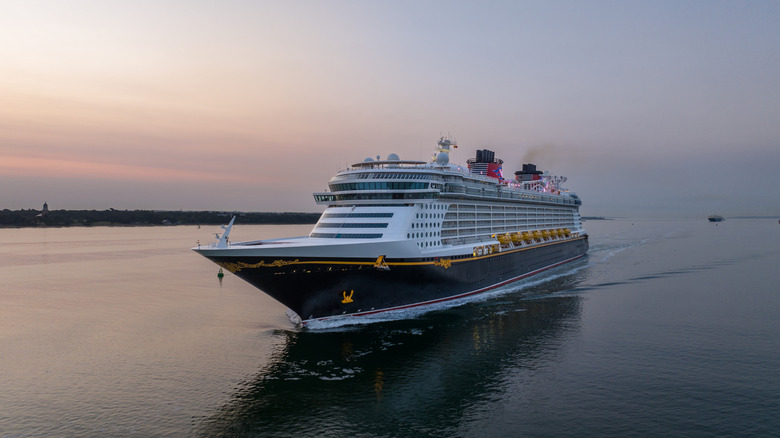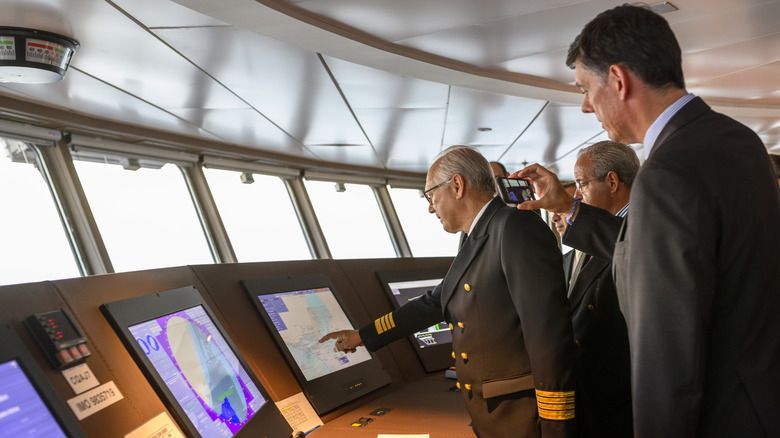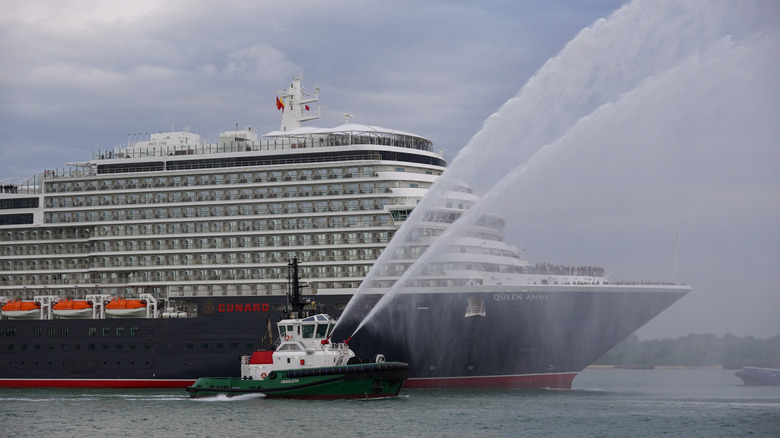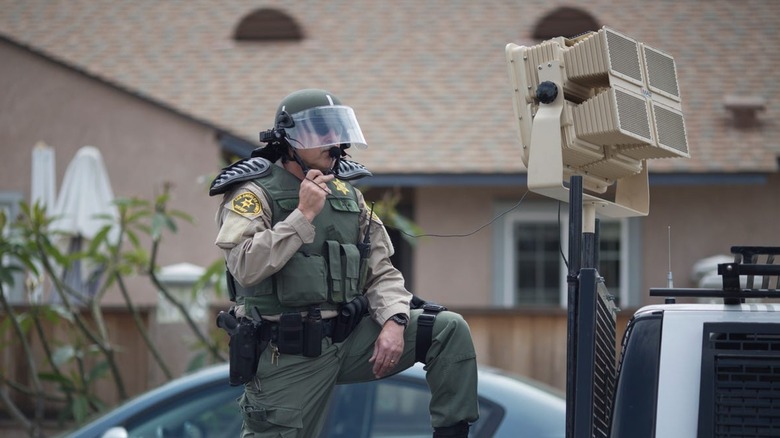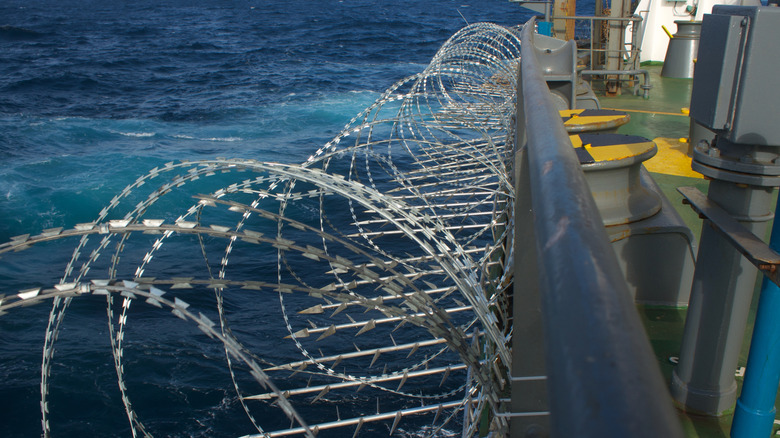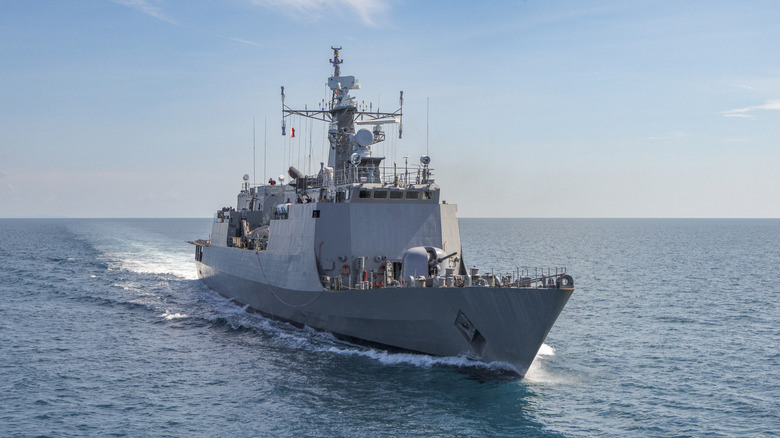Secret Tech Cruise Ships Use To Identify & Fight Modern Pirates
Cruise ships are some of the biggest seafaring vessels ever – even bigger than aircraft carriers. However, unlike aircraft carriers, cruise ships aren't armed to the teeth, which makes them giant targets for pirates, both figuratively and literally.
As surprising as it sounds, pirates are still sailing, although they have barely a shadow of the presence and relevance they did during the golden age. They don't patrol the high seas in large galleons but use motorboats to skulk around areas such as the Gulf of Aden and the Strait of Malacca. However, pirates are more dangerous than ever since they have traded muskets and cannons for assault rifles and RPG launchers. Pirates are so brazen, they can go after cruise ships, which can be veritable floating cities. They don't do it often – there have only been six reported attacks in the last decade – but that's still six more than most people are comfortable with. As such, cruise ship crews need to prepare for pirates who want to turn their ship into the seventh reported case, and part of preparation comes in the form of stashing defensive technology. Many hide devices and other items that can detect modern pirates and fend them off. Some of these hide in plain sight, while others are disguised or stored away until they are needed.
If the revelation that pirates can potentially attack cruise ships scared you out of vacationing on one, here's a few reasons why you shouldn't be scared.
Radio Warning Networks
When dealing with pirates, or anyone who wants to rob you for that matter, avoiding a situation where you have to encounter them is preferable to any where you do. You don't need to identify potential pirate ships, let alone fight them off, if you don't go anywhere near where they frequent. As they say, forewarned is forearmed.
It's no secret that cruise ships, like all large seafaring vessels, maintain radios to stay in touch with other ships and nearby shores. However, ship crews don't use these devices just to answer distress calls or report cases of norovirus. While cruise ship staff generally know what areas are rife with piracy, they stay in touch with nearby authorities to maintain an up-to-date forecast for potential pirate activity. Essentially, think of pirates like a weather system, except instead of getting rained on, you get robbed.
When cruise ships set out from port, the captains and crew always have an itinerary mapped out which includes the paths they will take across the ocean. If a radio picks up a forecast of a brewing storm, the helmsperson will change course to avoid it. Likewise, if nearby authorities call in to report unusually large pirate activities or sightings of pirates outside their usual routes, the captain and crew will reroute the vessel to avoid them. Like inclement weather, this strategy doesn't always work, but avoiding a bad situation is always a smart first move.
Early Detection Equipment
Technically, there is no catch-all piece of tech that lets people determine what is and isn't a pirate ship. After all, during the golden age of piracy, many pirate crews disguised their ships as friendly galleons and then raised the jolly roger when they got close. To suss out who is and isn't a pirate, you must rely on the tech everyone else uses.
In order to sail the somewhat-friendly seas, all cruise ships – and vessels in general – are equipped with common equipment such as radar and sonar. These are crucial to navigation, as they help detect underwater obstacles and notify crew of nearby ships. However, because of how these technologies work, sonar and radar can only detect that something is nearby, not what it is. A ping on the radar system could be a fishing vessel trawling for tuna, or it could be pirates lying in wait.
As with radar and sonar, cruise ships come equipped with plenty of visual aid tools such as binoculars. Crewmembers have them on hand to see far-away sights, which can help them know just how busy a port is or if a radar detection is a benign ship or a pirate vessel. However, according to rumors, cruise ships also pack more advanced surveillance systems, including night vision technology and thermal imaging cameras that let people keep a lookout during low-vision situations. While we can't confirm these claims, that's probably for the best since the exact technologies are allegedly kept confidential for security purposes.
Surprising Speed
Cruise ships aren't known for going fast. The largest travel an average of around 22 knots (25 mph). However, this "cruising" speed (hence the term "cruise ship") is designed to keep passengers comfortable and maintain maximum fuel efficiency. In an emergency, cruise ships can gun it, and pirates definitely count as an emergency.
While there are few cases of pirates attacking cruise ships, in the past, captains have been able to outspeed their pursuers. This was the case for the Seabourn Spirit (aka. The Star Breeze), which sped away from pirates as soon as they opened fire. Reports didn't indicate actual speeds, but the pirates were in little more than inflatable dinghies, which aren't exactly known for their ability to fly across the water. However, running away isn't the only method to leverage a cruise ship's engines against a pirate attack.
According to one of the Seabourn Spirit's passengers, the ship's captain didn't just run away from the pirates; he also zigged and zagged the ship to the best of his abilities. This might sound strange, but the captain was steering the ship to generate waves with the intent of knocking pirates around. The pirates got so close while in pursuit that the cruise ship almost rammed one dinghy. Thanks to the Seabourn Spirit's maneuvers, the pirates never got a chance to board the cruise ship. The Seabourn Spirit was on the small side for a cruise ship. Imagine what would have happened if pirates had attacked an Oasis-class vessel over 1,000 feet long.
Water Cannons
Just because boats are surrounded by water, doesn't mean they can't get dirty or catch on fire. Small vessels like tugboats are equipped with water hoses to deal with these situations, but when cruise ships are out on the open ocean, they have to clean themselves and put out their own fires with their own water cannons.
As anyone who lived through the civil rights movement will tell you, fire hoses pack a ton of power. While these tools were unfortunately used to break up protests during the 1960s, they also have the potential to wreak the same havoc on pirates. When they defended the Seabourn Spirit, crewmates Michael Groves and Som Bahadur Gurung used the ship's high pressure hoses to fend off pirates. A few years later, the crew of the MSC Melody used their cruise ship's water hoses to knock pirates off the ship's hull to similar results.
While cruise ships (and other large seafaring vessels) can use their fire hoses as makeshift water cannons, companies such as Dasic create actual water-based pirate deterrents. One of their latest products is the Nemesis 5000, an unmanned water cannon that sprays pirates with water, preventing them from boarding while also keeping the crew safe from return fire. Even if ships only have standard water hoses, besieged sailors have another trick up their sleeves: cleaning detergent. According to one passenger aboard the Sea Princess, the captain was ready to douse the ship's sides with a cleaning solution to create a slippery, impenetrable film.
LRAD
Many military-grade weapons and technologies rely on the principles of kinetics and chemistry (i.e., a primer ignites gunpowder in a cartridge, and rapidly-expanding gasses shoot a bullet forward). However, armies have been known to use more eccentric and sci-fi-esque weaponry, such as lasers that shoot drones out of the sky. Some of these gadgets are also utilized in civilian sectors, including cruise ships.
The Long-Range Acoustic Device (LRAD) is a sound-based weapon that military and police have been using for two-and-a-half decades. This device channels sonic waves into 154 decibels of ear-shattering pain, nausea, and hearing loss. For comparison, gunshots and jet engines are only 140 decibels. As it turns out, cruise ships can pack LRADs.
As previously mentioned, Michael Groves and Som Bahadur Gurung defended the Seabourn Spirit using water cannons, but those weren't their only weapons; they also used an LRAD to discombobulate the attacking pirates. That was the extent of the ship's armaments, but it was enough to make the pirates retreat. For their bravery, the Queen of England awarded Groves and Burung the Queen's Gallantry Medal and Queen's Commendation for Bravery, respectively. During the attack, Gurung was hit by a bullet but was dragged to safety and eventually made a full recovery.
Anything That Isn't Nailed Down
What is technology? Many people probably assume that only devices like the most advanced Android phones count as technology, but Miriam Webster defines technology as "the practical application of knowledge especially in a particular area." Therefore, virtually anything man-made can count as technology, especially when you need to fend off pirates.
While a cruise ship's staff usually takes charge when defending against pirates, it's not unheard of for passengers to join in. After all, their belongings and lives are on the line, too. However, since they're not crew members, they don't have access to any anti-pirate tech, so they must make do and use anything that isn't nailed down. According to some reports, passengers on the MSC Melody joined in the defense of their ship by hurling chairs and tables at pirates scaling the ship's hull. Pirates returned fire with actual guns, but the makeshift barrage of furniture helped turn the tide and scare off the pirates. Possibly.
Unfortunately, stories about the pirate attack on the MSC Melody are beset by a nasty case of "he said, she said." Some say the passengers and their chairs played a major part in the cruise ship's protection, while others claim the passengers only delayed the pirates long enough for the crew to mount a proper defense. Regardless, passengers made do with what they had, and they only escaped due to luck.
Barbed Wire
While modern pirates have access to more powerful weapons when compared to the pirates of old, they are still restricted by a similar set of limitations. If they can't board a ship, they can't plunder it or hold the passengers hostage.
According to reports, it's not unheard of for a cruise ship to be lined with barbed wire. For example, the crew of the Discovery allegedly placed razor wire (a variant of barbed wire designed to slice up hands rather than puncture them) over and on the ship's guard rails. Plenty of other large ships use barbed wire as well, but they're admittedly not that common on cruise ships.
In addition to barbed wire, cruise ships have been known to utilize other low-tech methods to fend off pirates. Case in point, below the Discovery's razor wire sat a line of logs. Not only would these have served as another obstacle for pirates trying to climb up and over the railing, they could have been dropped at a moment's notice, smashing into boarding ships and also any pirates underneath. These hazards scared off Somali pirates who tried to board the Discovery in 2010, despite them being armed with AK-47s. In fact, the razor wire and logs were so effective that many passengers didn't learn about the attack until well after the fact; only early-bird breakfast eaters witnessed the event unfold.
Guns
Cruise ships are a place of rest and relaxation — at least for the passengers, anyway. Crews, meanwhile, must stay on high alert all the time for their guests' needs. However, doing so requires using items that are best hidden away from prying eyes. They're always there, just out of sight and out of mind.
While cruise ship passengers aren't allowed to carry firearms while onboard, crew members often store firearms in safe and secure locations and only pull them out in an emergency, such as when pirates attack. Although, the definition of "crew" varies from ship to ship. Sometimes it only applies to the staff, but other times the term extends to private security guards hired to remain vigilant against pirates.
One of the more notable cases where private guards fended off pirates took place in 2009 off the coast of Somalia. These guards utilized a combination of small arms fire from pistols and a high-pressure water cannon loaded with seawater to prevent the pirates from boarding. All the while, passengers were secured in their cabins. While the hired help was effective in their attempts, they came under fire from the East African Seafarers Assistance Programme for their use of guns. The company's representative, Andrew Mwangura, chewed them out for not using an LRAD. In his defense, according to the Guardian, most ships don't arm their private guards with guns due to matters of safety, liability, and the laws of the countries where they dock.
The Navy
When you're on land and you've exhausted all options to deal with criminals, you usually call in a military force. This could include a SWAT team and their vehicles or the actual army. These forces aren't exactly available when you're out in the ocean, but another branch of the military sure is.
Despite the sheer size and vast emptiness of the Earth's oceans, ships are never too far from the naval vessels of one country or another. On one hand, this means that if any large ship, such as a cruise ship, is attacked by pirates, a battleship or aircraft carrier is always a phone call away. But on the other hand, naval ships can cause a ton of collateral damage even when officers pull their punches, so calling in the Navy to deal with pirates is considered a last resort. In 1985, Palestinian pirates hijacked the Achille Lauro and held everyone aboard hostage. These terrorists threatened to execute their captives if 50 Palestinian prisoners weren't released from Israeli prisons. While the pirates eventually surrendered, the U.S. Navy sent a SEAL team on the off chance they needed to take the ship by force.
While a Navy can help handle a pirate situation in a pinch, they also serve as an excellent anti-pirate prophylactic. Given all the times pirates have had their collective butts handed to them by naval ships, a military vessel serving as an escort can scare off would-be attackers.
P-Trap
We may be cheating a bit with this entry since it is a piece of technology designed for large ships in general. However, it serves as a nasty obstacle that makes pirates rethink approaching ships that utilize this particular device.
The P-Trap is touted as a "passive, non-lethal self-protection measure against piracy." Not to be confused with a plumbing P-Trap, this system consists of a series of "swivelbooms" that hang off the side of a ship and carry bars. Each bar drags a series of P-Trap lines on the surface of the water, sort of like how fishing lines work. However, the P-Trap is designed to catch prey much bigger than your average tuna.
When a pirate ship comes within range of the P-Trap lines, these ropes ensnare the propeller, which makes the engine stall. Moreover, the lines contain weak points that are designed to snap and detach from the larger P-Trap mechanism. This is intentional because otherwise the pirate ship would be dragged along with the fleeing vessel – and give pirates a rope to climb up onto the ship. By the time the pirates unwind the P-Trap line and restart their boat's engine, their target is long gone, and even if it weren't, the attackers would just get tangled in another P-Trap line if they tried again. Pair up the P-Trap with razor wire, and you could render a ship impregnable (at least in theory).
